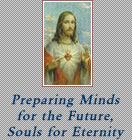 |
 |
|
|||||
|
|||||||
 |
|
|
© 2006 Sacred Heart School. All rights reserved. Archdiocese of Kansas City in Kansas |
|
Science Textbook Resources
 Features to note:
Features to note:
- Lesson number and title
- Vocabulary box. Note the page numbers next to each word. These numbers tell you where to find each word's definition in the lesson.
- "Get Ready" at bottom of first page of the lesson. This helps you start thinking about the ideas in this lesson.
- "Skill" label in the yellow section. This tells you what science skill will be focused on in the lesson's activities.
- Correlate the terms listed in the vocabulary box with the highlighted words in the text. Help students verbalize that if they want to review quickly or check their understanding, these are the words to pay special attention to, and being highlighted with yellow makes them easy to find.
- Each lesson also starts with an experiment or science lab, called the "Explore Activity", to get the reader hands-on experience with the lesson's content.
- The "Read to Learn" box tells the reader the main idea of the lesson.
- Each heading within the lesson is phrased as a question. After reading the section, students should answer the heading question to check their comprehension.
- There are also comprehension questions at the end of each section. These questions are marked with a red triangle and white question mark. They also help students check to see that they have understood the information they read in the section.
- Each lesson concludes with "Why It Matters" to explain how the information in the lesson fits into the overall picture, and how the concepts may affect us.
- At the end of each lesson, there is also a review section with "Think and Write" questions that help students review what they have just read and use the information to improve their critical thinking skills. This section is very handy when reviewing for tests!
- Additionally, point out the headings and subheadings within the text of the lesson. Emphasize that these are important information and help keep the text organized.
- Also, note the graphic elements such as photographs, maps, diagrams, graphs, and charts that provide additional information and help students to visualize what is being stated in the text. These are all part of the information, and should all be read and discussed to understand the lesson!
- At the end of the entire chapter, there is a Chapter Review. This is a helpful way to review what you've learned in all of the lessons of the chapter.
- You may also go to the textbook's online site for more related information and activities. http://www.science.mmhschool.com
See also the Answering Textbook Questions directions.

